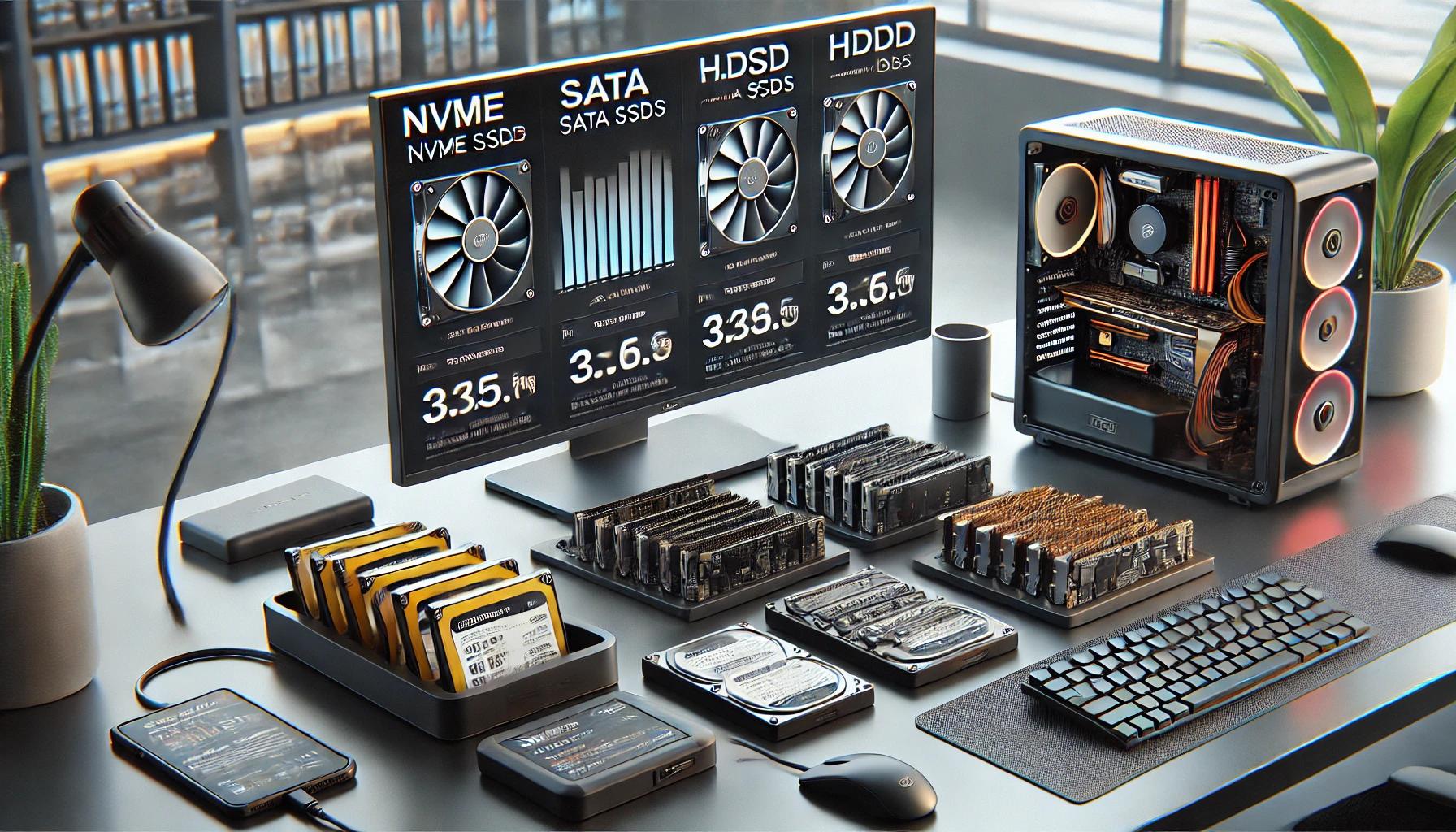Storage plays a crucial role in your PC’s speed, responsiveness, and data management. In 2025, there are more storage options than ever—ranging from lightning-fast NVMe SSDs to traditional hard drives and high-capacity external drives.
Choosing the right storage configuration can greatly improve your daily experience, whether you’re gaming, editing videos, or just browsing the web. This guide will walk you through the different storage types and help you decide what’s best for your setup.
Main Types of PC Storage in 2025
Let’s explore the three main categories of storage available today:
1. NVMe SSD (Non-Volatile Memory Express)
What it is:
A type of SSD that connects via PCIe interface—offering extremely fast read/write speeds.
Key Features:
- Form Factor: M.2 2280 (small, stick-shaped)
- Connection: PCIe Gen 3, Gen 4, or Gen 5
- Speeds: Up to 7,000 MB/s (Gen 4), and 12,000+ MB/s (Gen 5)
Best for:
- Operating system (Windows/Linux)
- Game installations
- Creative work (video editing, 3D rendering)
- Super fast boot and app load times
💡 Pros: Compact, ultra-fast, silent
🚫 Cons: More expensive per GB
2. SATA SSD
What it is:
A more affordable solid-state drive that connects via the SATA interface—slower than NVMe, but much faster than HDD.
Key Features:
- Form Factor: 2.5-inch (rectangle shape)
- Speeds: ~500–550 MB/s (limited by SATA III interface)
Best for:
- Budget-friendly builds
- Upgrading older PCs
- Secondary storage for games, files, or apps
💡 Pros: Affordable, fast, reliable
🚫 Cons: Larger than NVMe, slower performance
3. HDD (Hard Disk Drive)
What it is:
A traditional mechanical drive with spinning platters—offers massive storage at low cost.
Key Features:
- Form Factor: 3.5-inch (desktop), 2.5-inch (laptop)
- Speeds: ~80–160 MB/s (much slower than SSD)
Best for:
- Media libraries (movies, photos, music)
- Backups
- Cold storage (rarely accessed files)
💡 Pros: Inexpensive, high capacity (up to 20TB+)
🚫 Cons: Slow, noisy, fragile
4. External Storage
Options:
- Portable SSDs: Compact, fast, great for backups and portability
- External HDDs: Affordable and large capacity
- NVMe enclosures: Turn internal NVMe drives into external USB drives
Use Cases:
- Moving files between devices
- Backing up important data
- Expanding storage for laptops and mini-PCs
💡 Tip: Look for USB-C 3.2 or Thunderbolt 4 support for top performance.
Which Storage Type Should You Choose?
Let’s break it down by use case:
| Use Case | Recommended Storage Type |
|---|---|
| Fast boot and system drive | NVMe SSD (500GB–1TB) |
| Gaming | NVMe or SATA SSD (1TB+) |
| Budget build | SATA SSD + optional HDD |
| Mass storage | HDD (2TB–10TB+) |
| Portability | External SSD (1TB) |
| Creative work | NVMe SSD with Gen 4/5 speeds |
How Much Storage Do You Need?
Here’s a general guideline for modern systems in 2025:
- 500GB – Bare minimum, fills up quickly
- 1TB – Ideal for most users (OS + software + some games/files)
- 2TB+ – For gamers, editors, or media-heavy users
- 4TB+ – For advanced creators or archival systems
💡 Tip: Always leave ~10–20% of your SSD free to maintain performance and lifespan.
NVMe: Gen 3 vs Gen 4 vs Gen 5
| PCIe Generation | Read/Write Speed | Use Case |
|---|---|---|
| Gen 3 | ~3,500 MB/s | Basic tasks, gaming |
| Gen 4 | ~7,000 MB/s | High-performance builds |
| Gen 5 | 10,000–12,000+ MB/s | Extreme performance, future-proofing |
While Gen 5 is the fastest, it’s still relatively new and only necessary for advanced use cases.
Storage Tips for a Balanced Build
- OS and apps → NVMe SSD
- Games and media → Secondary SSD or HDD
- Backups → External drive or cloud
- Use disk partitioning to organize data logically
- Enable TRIM on SSDs for better performance and lifespan
Backup and Redundancy Matter
No matter which type of storage you choose, backups are essential. Use external drives or cloud services like Google Drive, OneDrive, or iCloud to prevent data loss.
For mission-critical files, consider:
- RAID 1 (mirroring)
- RAID 5/6 (parity)
- NAS devices for automated backups
Final Thoughts: Speed, Space, and Strategy
In 2025, the ideal PC storage setup combines speed (SSD) and capacity (HDD). NVMe drives are now the standard for fast booting and app loading, while HDDs remain useful for storing large files affordably.
Your best bet is a hybrid setup:
- Primary NVMe SSD (1TB) for OS and software
- Secondary SSD or HDD for storage and media
- External drive for backups and mobility
